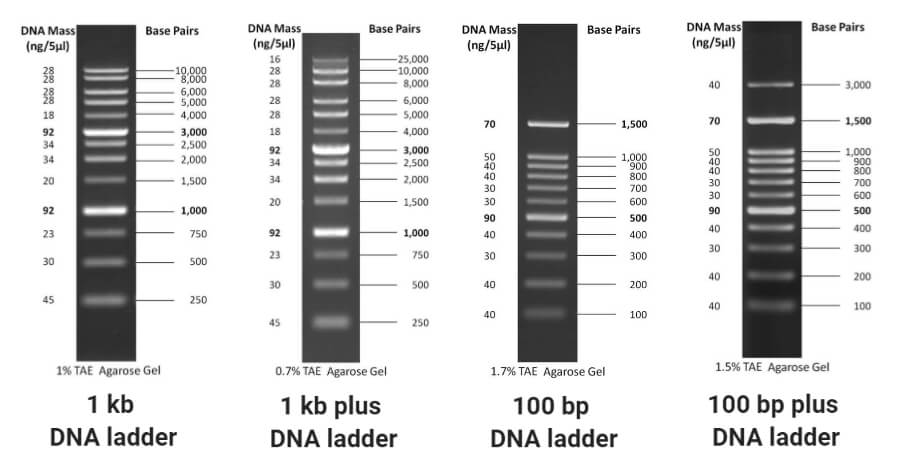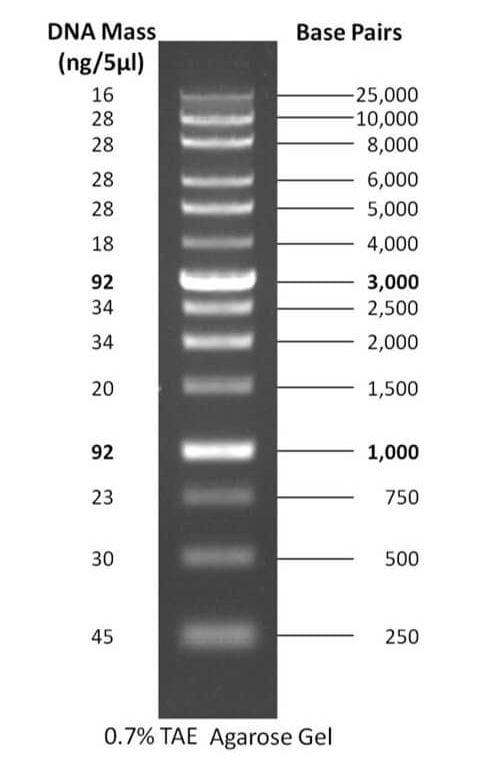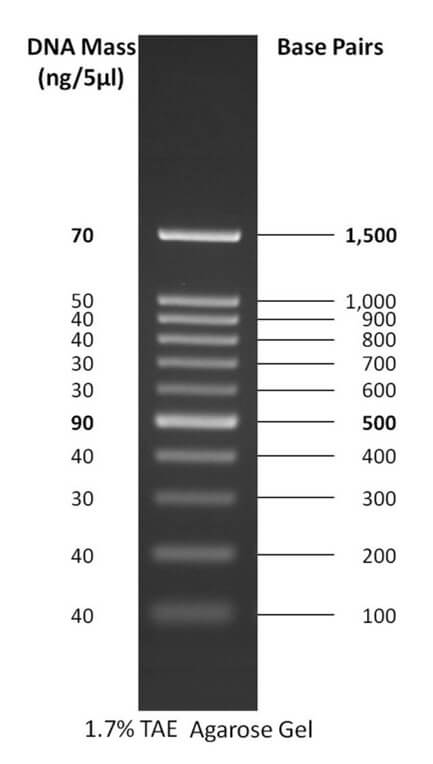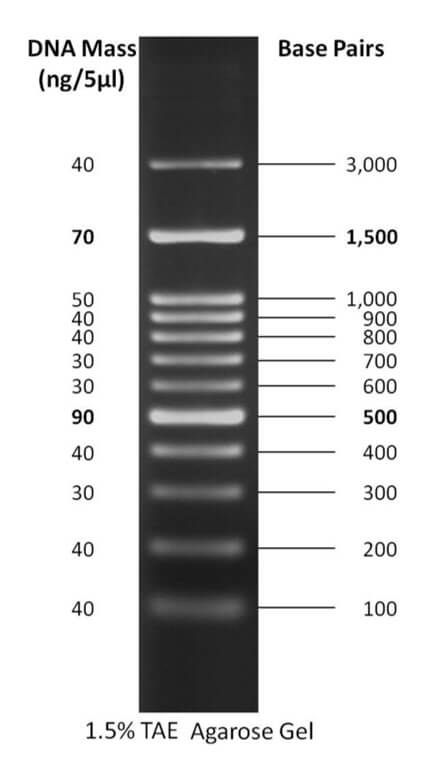Interesting Science Videos
DNA Ladder Definition
DNA ladder is a solution of DNA molecules of different lengths used in agarose or acrylamide gel electrophoresis which is used as a reference to estimate the size of unknown DNA molecules separated on the basis of their mobility in an electrical field through the gel. DNA ladders are essential molecules routinely used in every DNA dealing laboratory.

Figure: Some common DNA Ladders. Image Source: GoldBio.
- DNA ladders are also called molecular-weight size markers as they help to distinguish different DNA fragments based on their molecular weight, which in turn distinguishes them in terms of size.
- They have been used in various DNA related procedures ranging from the distinction between DNA variants to quantifying the number of mutations in a DNA fragment.
- The DNA ladder stains well with nuclear stains like ethidium bromide, which allows the visualization of DNA fragments after gel electrophoresis.
- Commercially available DNA ladders come in the 50 bp, 100 bp, 1000 bp, and 3000 bp form.
- These ladders are created by the digestion of known-length DNA fragments from natural sources by the restriction enzymes.
- The length of the fragments, thus, dependent on the restriction enzyme being used, this makes the process not entirely controllable.
- To overcome this disadvantage and make the ladder more flexible, DNA engineering was developed.
- Thus, for commercial purposes, a DNA fragment that contains a tandem repeat unit separated by the same unique restriction enzyme sites was cloned into a plasmid and then partially digested to produce a ladder with multimers of the repeats.
- More recently, however, many laboratory protocols describing the preparation of DNA ladders by employing the polymerase chain reaction (PCR) method have been reported.
- This method involves either the simultaneous amplification of a DNA target using primer sets or the separate amplification of different DNA targets using specific primers.
The DNA ladder being used for electrophoresis should have the following characteristics:
- The fragments within the ladder should be separable from each other.
- The concentration of individual fragments should be enough to be visualized after electrophoresis.
- The ladder containing loading dye should not affect the specificity of the DNA ladder.
- The fragments in the ladder should be stable enough to use for a long time.
- The ladder should be highly purified, avoiding unnecessary and unknown fragments.
Types of DNA ladder
DNA ladders are of different types depending on the length of the DNA fragments to be identified or the number of fragments present in the ladder. Some of the common types of DNA ladder are:
a. 1 kb DNA ladder
- 1 kb DNA ladder consists of 13 linear double-stranded DNA fragments which can be used to determine the size of DNA fragments with 250 bp to 10,000 bp.
- The 1 kb DNA ladder is a unique combination of a number of plasmids digested with restriction enzymes and PCR products to yield 13 DNA fragments that are suitable for use as a molecular weight standard for electrophoresis.
- The use of high intensity 1 kb DNA ladder helps in the quick and easy determination of electrophoresis results.

Figure: 1 kb DNA ladder. Image Source: GoldBio.
Description
- These ladders have reference bands at 1000 bp and 3000 bp for easy orientation.
- 1 kb ladder can be bought commercially at various concentrations, but the recommended load for an electrophoresis run is 0.5 µg (5µl).
- These can be used in either agarose or in polyacrylamide gels with the concentration of gel at 0.75% to 1%.
- These ladders come with different tracking dyes like bromophenol blue, xylene cyanol FF.
- The commercially available ladder is diluted to a 1:4 solution in water for use (3 parts water for 1 part ladder).
- 75 µl of water is combined with 25 µl of the DNA ladder to make a 100 µl solution.
- Then, 20 µl of the loading dye present with the kit is added, and the solution is split into 60 µl solutions (0.5 ml microcentrifuge tubes) and stored at -20°C.
- 3 µl of this diluted ladder is used per lane for a typical small (40 ml) agarose gel, which results in a concentration of approximately 0.63 µg of ladder DNA per lane.
- The 1 Kb ladders can be stored for varying times at varying temperatures like at 25ºC for six months, at 4ºC for 12 months and at -20ºC for 24 months in storage buffers like 10 mM Tris-HCl or 1 mM EDTA.
Uses of 1 kb DNA ladder
- The most essential and prominent use of the 1 kb DNA ladder is for the determination of the size of double-stranded DNA fragments of the length of 250 bps to 10,000 bps.
- The determination of the size of DNA fragments allows the quantification of DNA fragments and their relative size to one another.
- These DNA size standards can be used as controls during the electrophoresis process.
b. 1 kb plus DNA ladder
- 1 kb plus DNA ladder is a DNA size standard consisting of DNA fragments of length ranging from 0.5 kb to 10 kb used for the determination of the size of double-stranded DNA fragments of length ranging from 250 bp to 25,000 bp.
- 1 kb plus DNA ladder consists of 14 individual chromatography-purified DNA fragments.
- The purified DNA fragments result in sharp and clear bands that help with the identification process.

Figure: 1 kb plus DNA ladder. Image Source: GoldBio.
Description
- 1 kb plus DNA ladders usually have about 14 purified DNA fragments with a reference band at 1000 and 3000 bp for easy orientation.
- Most 1 kb plus DNA ladders are provided with loading dye which allows a convenient detection of sharp bands after electrophoresis.
- The amount of DNA or the number of DNA fragments is exact and precise in these ladders.
- 1 kb plus DNA ladders can be used in 0.7 to 1% agarose or polyacrylamide gels.
Uses of 1 kb plus DNA ladder
- The most important use of 1 kb plus DNA ladders is for the determination of the size of double-stranded DNA in the range of 250 bp to 25,000 bp.
- It helps to determine the size of DNA fragments that are much longer than the usual fragments, which allows the quantification of DNA fragments and their relative size to one another.
c. 100 bp DNA ladder
- A 100 bp DNA ladder is a DNA size standard used for the sizing and quantification of double-stranded DNA of the size in the range of 100 bp to 1500 bp.
- These ladders consist of about 11 highly purified DNA fragments that form separate clear bands for the identification of other DNA fragments within that range.

Figure: 100 bp DNA ladder. Image Source: GoldBio.
Description
- These ladders have reference bands at 500 bp and 1500 bp for easy orientation.
- The ladder is designed with a uniform intensity of DNA bands of different sizes for a clear view of each band.
- An exact amount of DNA is used in each band that allows approximate quantification of DNA samples.
- Some of these ladders can even be radio-labeled with T4 polynucleotide kinase or T4 DNA polymerase.
- This double-stranded DNA ladder can be visualized on 1–2% agarose gels after staining.
Uses of 100 bp DNA ladder
- These ladders can be used for the determination of the size of double-stranded DNA fragments of the range 100 bp to 1500 bp.
- It can also be used in diagnostic purposes like the molecular detection of pathogens and characterization of the genetic variability.
- Besides, it can be used for the molecular tagging of disease resistance genes.
d. 100 bp plus DNA ladder
- A 100 bp plus DNA ladder is a DNA size standard used for the sizing and quantification of double-stranded DNA of the range of 100 bp to 3,000 bp on agarose or polyacrylamide gels.
- The ladder has about 12 purified DNA fragments that form separate clear bands for the identification of other DNA fragments within that range.

Figure: 100 bp plus DNA ladder. Image Source: GoldBio.
Description
- These ladders have reference bands at 500 bp and 1500 bp for easy orientation.
- This double-stranded ladder can be used for the visualization in 1–2% gels.
- A defined amount of DNA in each band within the ladder enables approximate quantification of sample DNA.
- The ladders are generated from PCR and restriction enzyme digestion of double-stranded DNA.
- The ladder comes with a loading dye and loading buffer to enable the movement of the fragments through the gel slab.
Uses of 100 bp plus DNA ladder
- A 100 bp plus DNA ladder can be used as a DNA size standard for the visualization of linear double-standard DNA fragments of the size 100 bp up to 3,000 bp.
- It enables the identification and separation of samples with DNA fragments based on their molecular weight and size.
- This ladder, like others, can be used for diagnostic purposes for the molecular detection of various pathogens in different samples.
References
- Wilson, K., Walker, J. (2018). Principles and Techniques of Biochemistry and Molecular Biology (8 eds.). Cambridge University Press: New York.
- Zhang, G., Fenyö, D., & Neubert, T. A. (2008). Use of DNA ladders for reproducible protein fractionation by sodium dodecyl sulfate-polyacrylamide gel electrophoresis (SDS-PAGE) for quantitative proteomics. Journal of proteome research, 7(2), 678–686. https://doi.org/10.1021/pr700601y
- Lan et al. (2012). Straightforward Procedure for Laboratory Production of DNA Ladder. Journal of Nucleic Acids. Volume 2012. https://doi.org/10.1155/2012/254630.
- Sharma, Tilak. (2003). Molecular Diagnosis and Application of DNA Markers in the Management of Fungal and Bacterial Plant Diseases. Indian J. Biotechnol.
- Matthew M.Ferris, Xiaomei Yan, Robbert C. Habbersett, Yulin Shou, Cheryl L. Lemanski, James H. Jett, Thomas M. Yoshida, Babetta L. Performance Assessment of DNA Fragment Sizing by High-Sensitivity Flow Cytometry and Pulsed-Field Gel Electrophoresis. Journal of Clinical Microbiology May 2004, 42 (5) 1965-1976; DOI: 10.1128/JCM.42.5.1965-1976.2004
- https://www.thermofisher.com/order/catalog/product/10787018#/10787018
- https://www.thermofisher.com/order/catalog/product/SM0321#/SM0321
- https://www.thermofisher.com/order/catalog/product/15628019#/15628019
- https://eng.bioneer.com/20-d-1030-cfg.html
- https://www.goldbio.com/product/1-kb-dna-ladder
- https://www.goldbio.com/product/1-kb-plus-dna-ladder
- https://www.goldbio.com/product/100-bp-dna-ladder
- https://www.goldbio.com/product/92/100-bp-plus-dna-ladder
